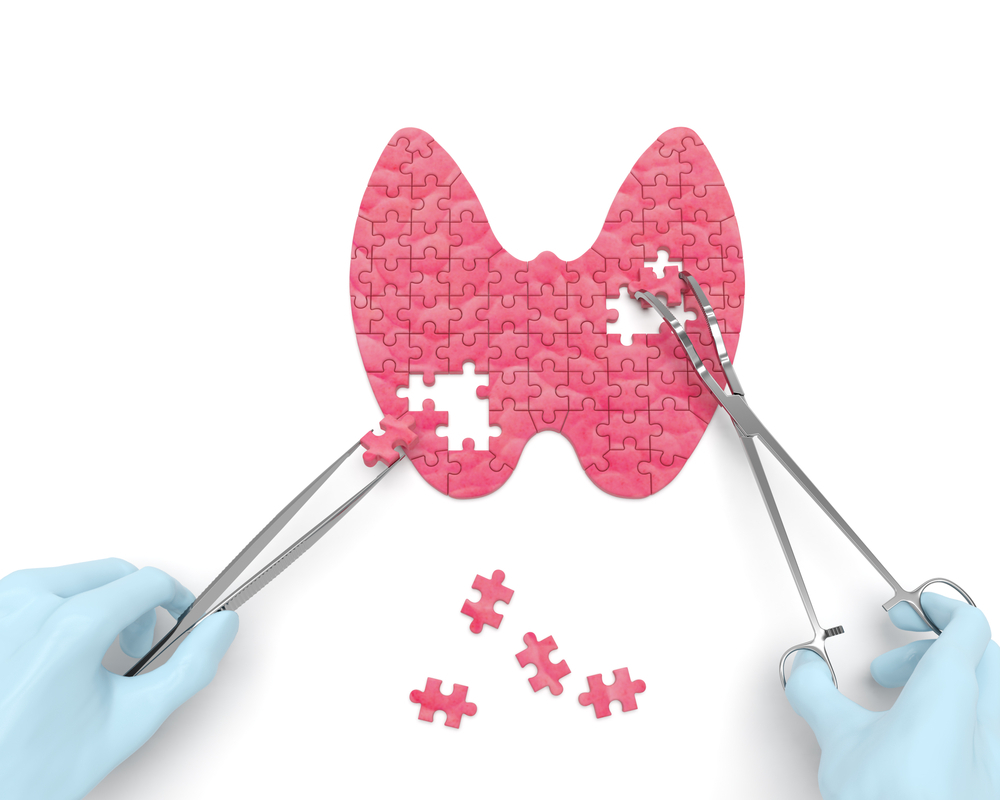Tinjauan Medis Hipertiroidisme
RINGKASAN PEMBUKAAN
- Kelenjar tiroid bisa menjadi terlalu aktif, melepaskan sejumlah besar hormon tiroid yang tidak normal. Sel kanker juga dapat melepaskan hormon yang telah dibentuk sebelumnya ke dalam sirkulasi. Hipertiroidisme terjadi akibat kelebihan hormon ini.
- Volume hormon tiroid yang beredar sangat bergantung pada bentuk Hipertiroidisme - Subklinis atau Terbuka. Namun, dalam kedua bentuk tersebut, kadar TSH meningkat secara tidak normal.
- Penyebab paling umum dari peningkatan hormon tiroid adalah tiroiditis dan gondok nodular toksik. Hipertiroidisme yang terkait dengan gondok nodular toksik muncul dengan gejala berat dan sulit untuk ditangani. Tiroiditis muncul dengan infiltrasi limfositik tiroid.
- Pengukuran kadar hormon tiroid dalam darah, meskipun populer, adalah pendekatan yang tidak akurat untuk menentukan fungsi tiroid. Ini karena 75% dari hormon tiroid ditemukan di kulit, otak, dan otot. Fakta tunggal ini membuat Tes Darah Tiroid menjadi tes yang kontroversial dan tidak akurat untuk diagnosis Hipertiroidisme dan penyakit tiroid lainnya.
- Saat ini, pendekatan pengobatan yang paling populer berdasarkan keparahan penyakit, presentasi gejala dan pilihan pasien termasuk obat Anti-tiroid (ATD), Bedah (Tiroidektomi), dan Ablasi Yodium Radioaktif.
PENGANTAR: Gambaran Klinis dan Gambaran Penyakit
Hyperthyroidism describes a pathological syndrome characterized by the excessive production of thyroid hormones as a direct result of the excessive synthesis of thyroid hormones, uncontrolled release of preformed hormones or additional release of thyroid hormones from cancerous cells of the thyroid gland. In almost all cases of Hyperthyroidism, the overactive thyroid gland causes a hyper-metabolic condition of the Thyrotoxicosis.
Affecting a sizable number in the population, Hyperthyroidism has been reported by different Health surveys to have a prevalence rate of 0.8% in Europe, 1.3% in the United States and an increasing rate in the developing countries of the World, especially in iodine-deficient areas. Clinicians have described the two presentation forms of Hyperthyroidism –Subclinical Hyperthyroidism and Overt Hyperthyroidism. Subclinical Hyperthyroidism presents with low serum thyroid-stimulating hormone (TSH), and normal levels of serum thyroxine (T4) and triiodothyronine (T3). In contrast, Overt Hyperthyroidism presented with low serum TSH and increased concentration of T4 and T3.
It is a commonplace to read Medical reviews in which ‘Thyrotoxicosis’ and ‘Hyperthyroidism’ are used interchangeably. However, in perspective, these terms are different though intertwined. Thyrotoxicosis only defines the state of excess thyroid hormone exposure to tissues with Hyperthyroidism considered the result of excessive thyroid functioning. Hyperthyroidism is thus a major etiology of Thyrotoxicosis, and Thyrotoxicosis can occur with or without Hyperthyroidism.
The Pathogenesis of Hyperthyroidism is not definite and depends on the underlying thyroid dysfunction causing a significant surge in the levels of thyroid hormones available in the tissues. The most commonly documented causes of Hyperthyroidism include Graves’ Disease, thyroiditis and toxic nodular goitre. In Graves’ disease –an autoimmune thyroid dysfunction, there is an increased production of thyroid-stimulating immunoglobulins that mimics the effects of TSH when combined with TSH receptors. In Hyperthyroidism caused by Graves’ disease, the patients present with plaque-like thickening of the skin and a condition described as ‘Ophthalmopathy of Graves’ (thyroid eye) –inflammation of the retro-orbital tissues.
Hyperthyroidism caused by toxic nodular goitre is mostly diagnosed in older patients. Considered the most common cause of Hyperthyroidism, toxic nodular goitre presents as monoclonal thyroid tumours secreting excess thyroid hormones. At first, the patient develops subclinical Hyperthyroidism which gradually leads to overt Hyperthyroidism when not diagnosed early or managed on time. Hyperthyroidism can also be caused primarily by thyroiditis –an autoimmune dysfunction of the thyroid characterized by inflammation of the thyroid glands as a result of lymphocytic infiltration. This infiltration induces thyroid cell destruction and the premature release of thyroid hormones for the destroyed cell stores.
The symptoms presentation in patients with a suggestive diagnosis of Hyperthyroidism depends on patients age, sex, medical history and disease course, disease pathogenesis and duration of onset. Symptom documentation can include palpitations, tachacardia, weight gain, dyspnea, unexplained fatigue, muscle weakness, nervousness, frequent bowel movements and irregular menses in women. Some patients also present with enlarged thyroid glands and hoarseness of the voice. Accurate evaluation of symptoms of Hyperthyroidism by caregivers requires an expert experience as subclinical Hyperthyroidism can present with vague and non-definite symptoms.
Pendekatan Diagnosis dan Metode Perawatan Saat Ini
Regardless of the disease duration and pathogenesis, Hyperthyroidism causes a significant dysfunction in thyroid functioning. The diagnosis method is thus directed toward as accurate assessment of thyroid functioning. A popular, but inaccurate method of evaluating thyroid functioning is based on measuring the levels of thyroid-stimulating hormone (TSH), T4, T3 and TSH-receptor antibodies. These measurements are believed to reveal thyroid dysfunction, if any, and also differentiate between the two forms of Hyperthyroidism. In many clinics around the World, the Thyroid Blood Test is still considered the most sensitive diagnostic test for Hyperthyroidism, however the test for Graves (TGab) is a valid blood test.
In line with the findings or Dr Richard Bayliss –a consultant Endocrinologist –THS is not a good indicator of Thyroid functioning, and at best can only suggest to the clinician the onset of thyroid impairment. Thyroid Blood Tests determines the level of Thyroid hormones in the blood as a Clinical diagnostic test for thyroid dysfunction. However, different medical enquiries have revealed that only 18% of the total thyroid hormones can be found in the blood, with about 75% present in the skin, brain and muscles. This single fact makes Thyroid Blood Tests controversial and inaccurate tests for the diagnosis of Hyperthyroidism and other thyroid diseases.
Tes Tiroid memberikan gambaran yang lebih akurat tentang fungsi tiroid jika dibandingkan dengan Tes Darah Tiroid. Thyroflex menggabungkan presentasi gejala, Resting Metabolic Rate, dan laju konduksi impuls melalui saraf untuk menilai fungsi tiroid. Memberikan bukti obyektif dengan perkiraan akurasi 98%, Tiroflex dengan cepat menjadi alat diagnostik standar emas untuk penilaian klinis disfungsi tiroid.
Protokol Pengobatan untuk Hipertiroidisme
The treatment of Hyperthyroidism is aimed at decreasing the level of thyroid hormone production and ultimately improving thyroid functioning. Currently, the most popular treatment approaches based on disease severity, symptom presentation and patients’ choice include Anti-thyroid drugs (ATD), Surgery (Thyroidectomy), and Radioactive Iodine Ablation.
Anti-thyroid drugs are administered at the lowest that effects the maximum effect on the thyroid. Once administered, these directly blocks the biological processes leading to the synthesis of the thyroid hormones. The conventional Anti-thyroid drugs currently in use across different regions if the World includes propylthiouracil, thiamazole, and carbimazole. These dugs also have immunosuppressive and immunosuppressive actions that are considered advantageous in Hyperthyroidism cased b an autoimmune reaction or characterized by thyroid inflammation. Drug therapy is, however, contraindicated in pregnant women.
In cases where Hyperthyroidism has been diagnosed to be caused by Graves’ disease or toxic multinodular goitre, Radioactive Iodine Therapy is considered a cost-effective first-line therapy. This therapy method uses radioactive iodine to effect a significant shrinkage of the thyroid and consequently induce a decreased production of thyroid hormones. Also contraindicated during pregnancy, Radioactive Iodine Therapy is sometimes combined with Anti-thyroid drugs for maximum effect.
Intervensi bedah direkomendasikan pada kasus Hipertiroidisme dengan resistansi yang cukup besar terhadap terapi obat. Tiroidektomi melibatkan pengangkatan sebagian atau seluruh tiroid. Pendekatan ini secara luas dianggap sebagai pengobatan yang paling berhasil untuk Hipertiroidisme karena tingkat kekambuhan berkurang secara signifikan, dan fungsi tiroid yang normal tercapai dalam beberapa minggu setelah prosedur.
Prognosis Hipertiroidisme membaik dengan diagnosis dini dan pengendalian gejala. Terlepas dari terapi pilihan, fungsi tiroid dipantau selama sekitar dua bulan setelah keadaan eutiroid dipastikan. Tes Tioflex menawarkan rencana penilaian fungsi tiroid pasca terapi yang paling akurat.
REFERENSI
- www.ncbi.nlm.nih.gov/pmc/articles/PMC5014602/#!po=35.0394
- www.ncbi.nlm.nih.gov/m/pubmed/26926973/
- emedicine.medscape.com/article/121865-overview#a1
- www.thyroflex.com
- www.thyroid.org/hyperthyroidism/
- www.niddk.nih.gov/health-information/endocrine-diseases/hyperthyroidism


